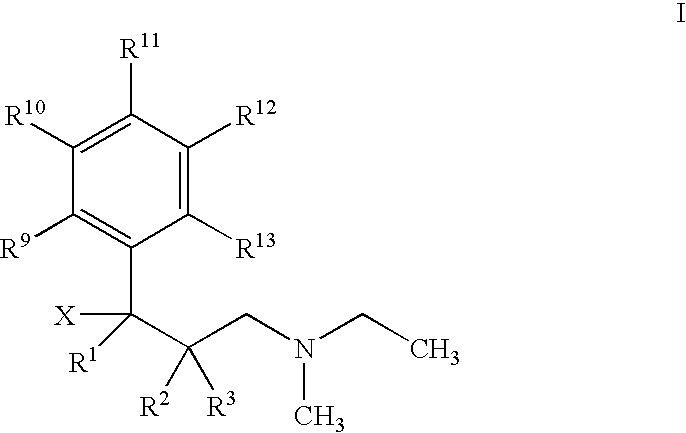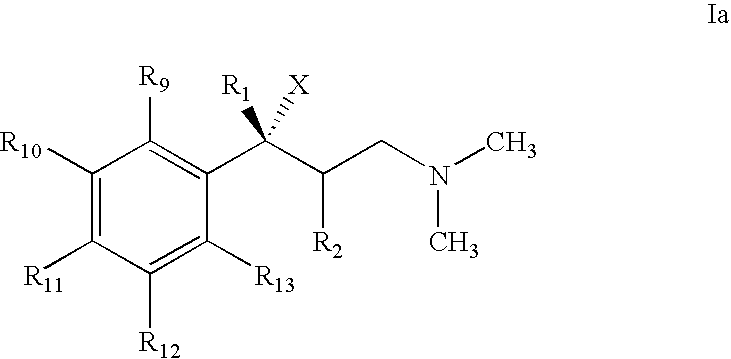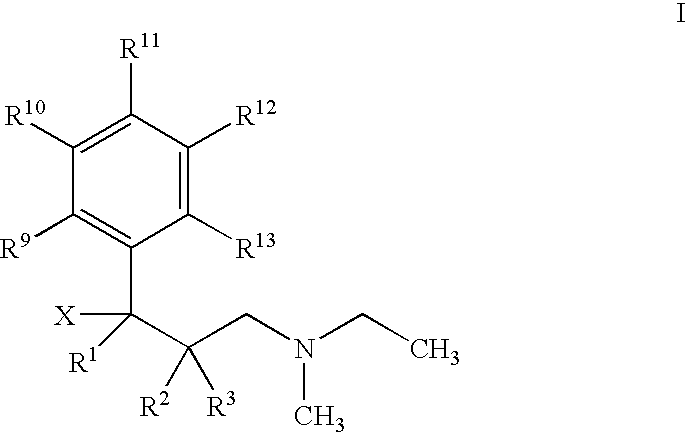Use of 1-phenyl-3-dimethylaminopropane compounds for treatment of urinary incontinence
a technology of dimethylaminopropane and phenylamine, which is applied in the direction of biocide, drug composition, urinary disorder, etc., can solve the problems of urgency incontinence, urinary incontinence, and incontinence in an uncontrolled manner
- Summary
- Abstract
- Description
- Claims
- Application Information
AI Technical Summary
Benefits of technology
Problems solved by technology
Method used
Image
Examples
example 1
List of Tested Substances
[0145] The following is a list of the compounds tested as regards their effectiveness:
1 Cmpd. Name No. (2RS,3RS)-1-dimethylamino-3-(3-methoxyphenyl)-2-methyl- 1 pentan-3-ol, hydrochloride (+)-(2R,3R)-1-dimethylamino-3-(3-methox-yphenyl)-2- 2 methylpentan-3-ol, hydrochloride (2RS,3RS)-3-(3,4-dichlorophenyl)-1-dimethylamino-2- 3 methylpentan-3-ol, hydrochloride (2RS,3RS)-3-(3-difluoromethylphen-yl)-1-dimethylamino-2- 4 methylpentan-3-ol, hydrochloride (2RS,3RS)-1-dimethylamino-2-methyl-3-(3-methylsulfanyl- 5 phenyl)-pentan-3-ol, hydrochloride (3RS)-1-dimethylamino-3-(3-meth-oxyphenyl)-4,4-dimethyl- 6 pentan-3-ol, hydrochloride (2RS,3RS)-3-(3-dimethylamino-1-ethyl-1-hydroxy-2-methyl- 7 propyl)-phenol, hydrochloride (1RS,2RS)-3-(3-dimethylamino-1-hydro-xy-1,2-dimethyl- 8 propyl)-phenol, hydrochloride (+)-(1R,2R)-3-(3-dimethylamino-1-hydroxy-1,2-dimethyl- 9 propyl)-phenol, hydrochloride (+)-(1R,2R)-3-(3-dimethylamino-1-hyd-roxy-1,2-dimethyl- 10 propyl)-phenol, hy...
example 2
Cystometry Tests on Conscious Fresh Rats
[0146] Cystometry investigations were carried out on fresh female Sprague-Dawley rats according to the method of Ishizuka et. al. ((1997), Naunyn-Schmiedeberg's Arch. Pharmacol. 355: 787-793). Three days after implantation of bladder and venous catheters the animals were investigated in the conscious state while freely moving. The bladder catheter was connected to a pressure gauge and an injection pump. The animals were placed in metabolic cages that enable the volume of urine to be measured. Physiological saline solution was infused (10 ml / hour) into the emptied bladder and the bladder pressure and volume of urine were continuously recorded. After a stabilisation phase a 20-minute phase was recorded that was characterised by normal, reproducible micturition cycles. The following parameters among others were measured:
[0147] threshold pressure TP, bladder pressure immediately before micturition,
[0148] bladder capacity BC, residual volume after ...
example 3
Cystometry Investigations in Narcotised Fresh Rats
[0154] The cystometric investigation was carried out on fresh female rats according to the method of Kimura et al. (Kimura et al., 1996, Int. J. Urol. 3: 218-227). The abdomen of narcotised ventilated rats is opened and the ureter is ligated. The urine is drawn off from the kidneys. A catheter is inserted into the bladder and secured in place. Saline is infused by means of an infusion pump via the catheter into the bladder until this exhibits rhythmic spontaneous activity in the form of contractions that can be recorded via a connected pressure recorder. The test substance is applied intravenously in a cumulative manner after stable starting values were reached. An effect on the bladder function is manifested by the suppression of the spontaneous contractions. The disappearance of the contractions over a period of 10 minutes serves as a parameter for their suppression.
[0155] With all the substances listed there was a measurable suppr...
PUM
| Property | Measurement | Unit |
|---|---|---|
| pure diastereomer | aaaaa | aaaaa |
| enantiomer | aaaaa | aaaaa |
| pressure | aaaaa | aaaaa |
Abstract
Description
Claims
Application Information
 Login to View More
Login to View More - R&D
- Intellectual Property
- Life Sciences
- Materials
- Tech Scout
- Unparalleled Data Quality
- Higher Quality Content
- 60% Fewer Hallucinations
Browse by: Latest US Patents, China's latest patents, Technical Efficacy Thesaurus, Application Domain, Technology Topic, Popular Technical Reports.
© 2025 PatSnap. All rights reserved.Legal|Privacy policy|Modern Slavery Act Transparency Statement|Sitemap|About US| Contact US: help@patsnap.com



